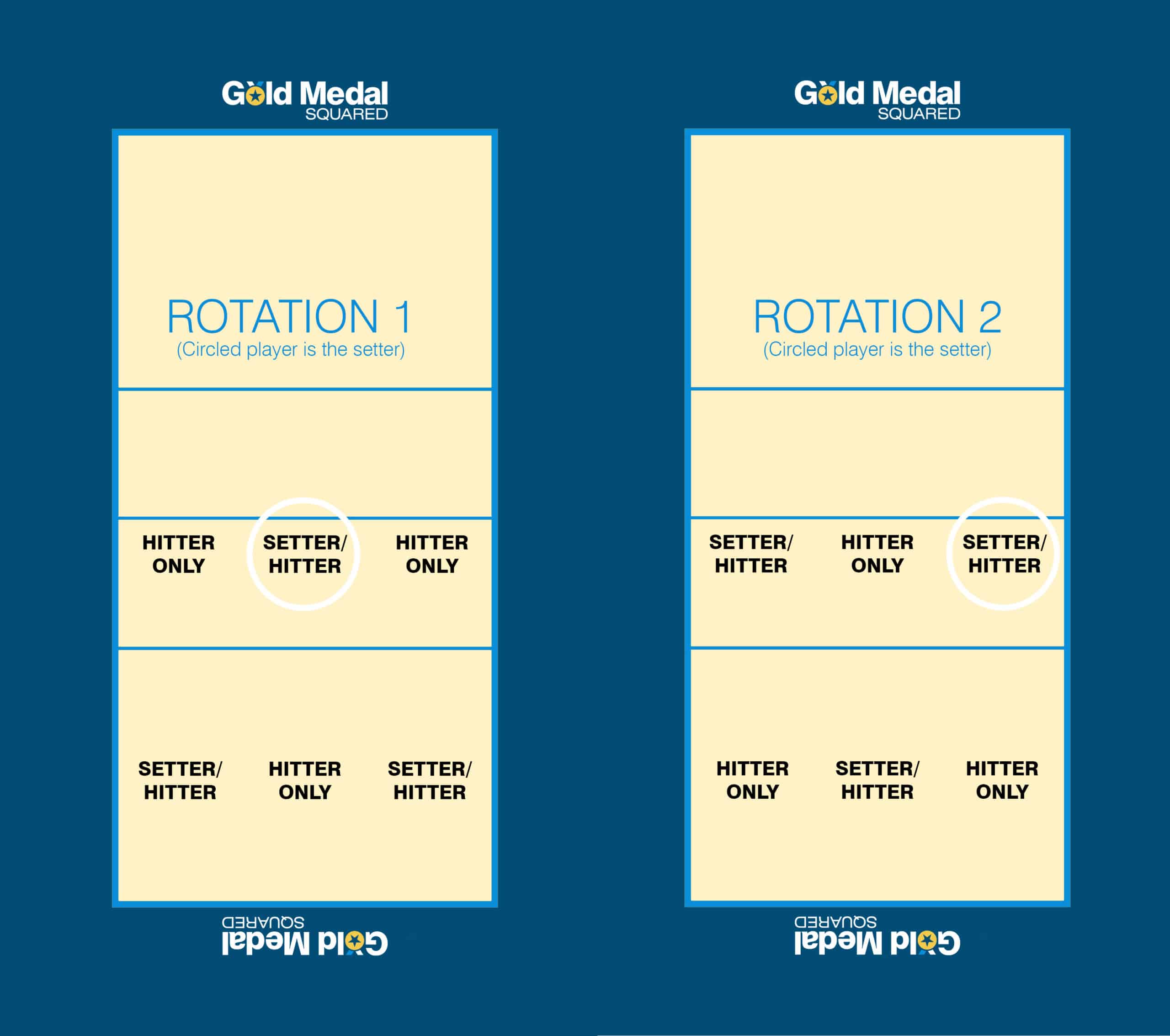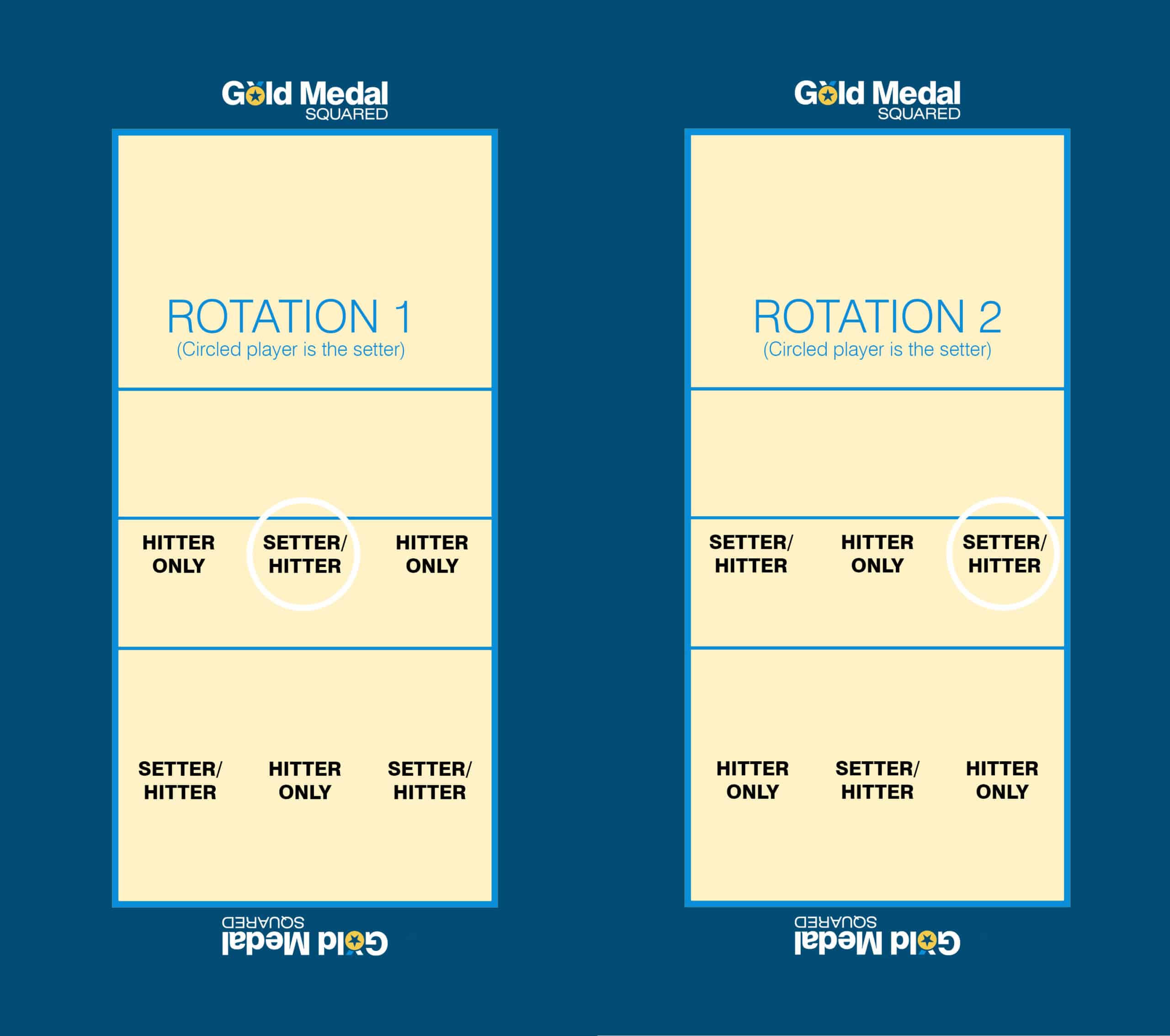The 6-3 Offense in volleyball
Young or new volleyball teams typically start out using the most basic systems. One of the options to consider when coaching a younger team is the 6-3 offense in volleyball. It is rarely used in the higher levels of the game but can be a great option for developing teams who still want to find a competitive edge. It allows players to develop a whole range of skills and to be adaptable whilst introducing the first stage of specialization of the setter position.
One pitfall that occurs in volleyball at the youth level is over-specialization at too young of an age. When a player is still learning the game, limiting repetitions to certain skills (eg. not allowing the “middles” to practice passing or the “liberos” and “setters” to attack) will restrict their overall understanding of the game. Part of the learning process for any player is to get a feel for each skill and apply the skill in a competitive situation; to broaden their knowledge of the roles of all of the playing positions in the team.
The 6-3 offense aids this process by providing opportunities for multiple players to practice all aspects of the game and grow in confidence in a competitive environment.
how do 6-3 volleyball rotations work?
When using the 6-3 offense in volleyball, the starting line-up will consist of 3 players who will be designated as hybrid setter/attackers and 3 players who will be designated as attackers only. Players will alternate in the lineup on the court so that two hybrid players will never be next to one another and likewise, two designated attackers will never be next to each other. The basic concept behind this system is that players will not switch positions during rallies. They remain in the same position that they start in for the whole point and fulfill whatever role is designated for that particular position.
There are two ways to run this type of offense:
1) When one of the hybrid players is in Zone 1 or Zone 6, that player is the designated setter. This results in having three front-row attackers at all times.

2) When one of the hybrid players is in Zone 2 or Zone 3, that player is the designated setter. This results in having only two offensive attackers, but three primary defenders in the backrow.

6-3 System Summary:
- The team consists of 3 players who will both set and attack, and 3 players who will only attack;
- Every hybrid setter/attacker will set for two consecutive rotations.
- All players are able to remain on court for all rotations without any substitutions required.
Advantages of the 6-3 Offensive System
Although this system is the first developmental stage towards ‘positional specialization’, players are still able to experience and practice multiple aspects of the game, whilst still being able to compete. Training all of the skills is great for development, but in a game scenario, there are more factors to consider such as being able to react to the game plan of the opposition and problem solve, something that isn’t always replicated in drills for skill development. For example, as a middle/opposite for my junior volleyball career, I had limited passing opportunities, and so I was only able to learn how to pass in a competitive environment through playing Beach Volleyball, and this helped me with transitioning to different positions in my collegiate career. Competitive repetitions for all skills can be beneficial for a developing athlete.
In match situations, players not only have to execute the skills effectively but also need to learn to communicate effectively with teammates. They have to develop aspects such as individual composure and leadership. By using this 6-3 system for teams that are still developing, it is possible to limit the complexity of the systems that higher-level teams run. Players are able to know exactly what role they need to fulfill just by knowing which position they are in on the court. This means that they are not worrying about more complex systems in an already stressful environment and can just focus on being present in the game.
In terms of setters, this system accepts that a developing team is unlikely to have a single, high-quality setter who will run the offense; rather it focuses on developing three setters.
The 6-3 system also allows coaches to see where individual attackers are most comfortable attacking from. With attackers hitting through all three positions on the net, when the time comes for specialization as players become more advanced, coaches will have been able to see players playing in different roles and will not be confined to the usual stereotyping such as “this player is tall so they can be a middle” or “this player can’t play defense so they must be an opposite.” It allows coaches to make more informed decisions about the best pathways for their athletes to utilize their strengths.
Advantages Summary:
- Three setters are being developed.
- Players get to learn and practice multiple skills, all players pass, block, defend, attack. Setting becomes the only isolated skill that only some players will practice;
- Very simple – No switching; very basic serve-receive formations;
- A way to enter competitions and allow players to grow without adding complexity to the competitive environment;
- Coaches can see in a competitive environment where players are good at attacking from in order to specialize later on in the players’ development.
Disadvantages of the 6-3 Offensive System:
At the developmental or junior stages of the game, having 3 different setters is not the biggest issue. However, when players start to run different tempo sets and begin to form connections with different setters the variation in setters can cause a few problems. This might require a bit of tinkering with the system to pair up attackers and hybrid players who maybe have good connections so that it becomes possible to utilize these relationships within your team.
Looking at practice planning, in the stages of player development you will be more likely to isolate skills and work on them individually, so will have time to develop each of the individual skills for all of your players. However, once teams start to develop over the course of a season, the likelihood is that you might still require individual skill repetitions but need to balance the workload with team-related drills. A coach will require more awareness to effectively plan practices that benefit the whole team, rather than being able to have multiple drills for types of specialized players.
With specialization, there is a tendency to have leadership responsibilities attached. For example, when running a system with one setter on the court, their job is to run the offense. When there is a libero on the court, this player takes control of the passing unit and ensures that all of the other passers are on the same page. With a 6-3 system, one potential problem is that players have to step up into leadership roles without them being necessarily defined by position. Players have to be confident in their abilities to be able to talk on the court and help the other athletes around them. Often when a game is not going a team’s way, one of the first things to disappear is communication. Just something to be aware of.
Whilst there is the positive side of not having to switch positions when the ball is in play, it will require players to understand the role that they need to play within their position on the court. Especially with hybrid players when they are switching from playing as setters to attackers and visa versa, there needs to be a good enough understanding of the game so that the system works fluidly. This also requires the setters to be able to set from both positions 2 and 3, which means that the distances to the attackers will vary and so they need to understand the differences in the sets.
Disadvantages Summary:
- 3 different setters mean 3 potential different rhythms of setters for attackers to get used to.
- Lack of a designated “outside hitter,” etc.
- With specialization comes responsibilities, so how do you manage controlling the offense/passing unit etc?
- Players need to know and understand what role they are playing in each position on the court.
- Setters will have to set from two different positions on the court.
What style of team might benefit from running the 6-3 system?
Personally, I am a really big fan of the concept of this system for developing teams. One of the best ways to understand how to fulfill a role on the team or to know what your teammates need from you is to play all of the positions so that you know how each variable affects that particular position. For example, as a left-handed right-side attacker, when I play through position 4, I prefer a higher ball. However, this is not always a concept I can get across to setters because they haven’t experienced the problems that I might run into with a lower set. By playing all positions, and learning all skills, players are more adaptable and should be more open to feedback from their teammates and coaches, a valuable skill to possess.
The system is also a good idea for teams that want to understand the strengths of their athletes in order to specialize at a later time. Coaches are able to observe their attackers through a variety of positions on the court and can see which players are more competent in passing. They can also start to see who takes on the responsibility of leadership or if this is a void within their team.
The system also suits teams that have players who can reasonably volley or set the ball but are not yet capable of running a more complicated offense, or need to be slowly coaxed into such a role. It’s possible to limit the information or workload of a setter by having them set for fewer rotations, and begin to point out the finer details of the position, such as the different types of sets; variance in tempo and what different attackers need etc.
Style Summary:
- Teams learning the game – teaches them to communicate and work together.
- Developing teams ready to move onto the first stages of specialization.
- Teams who do not know what their strengths and weaknesses are yet.
- Teams with players who can set but are not yet ready to run a full offense.
Learn About Other Volleyball Systems In Our Blog
